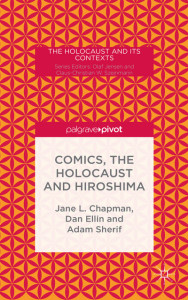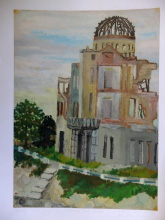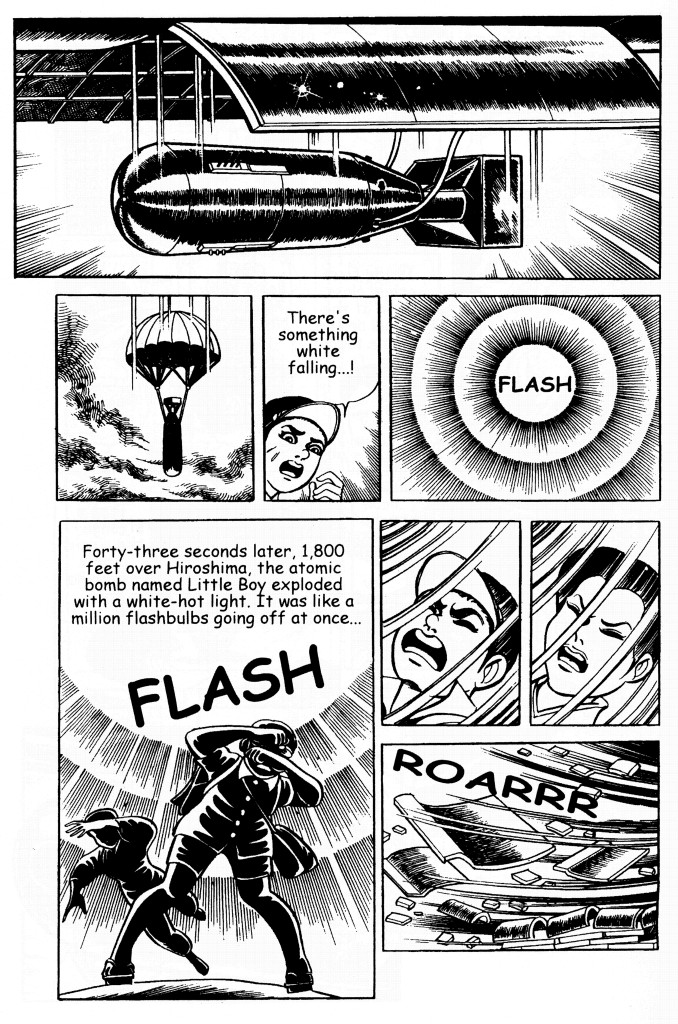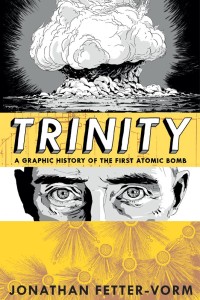Next month sees the 70th anniversary of the atomic bombing of Hiroshima and Nagasaki, one of the final, horrific closing acts of World War Two that has, of course, proven a rich vein of story inspiration for comic creators down the years – and its depiction has sometimes proven contentious.
In 2013 for example, the Daily Telegraph reported how a regional board of education in Japan withdrew the most famous Hiroshima story, Barefoot Gen, by survivor Keiji Nakazawa from school libraries, triggering a debate about whether it is appropriate to show the full horror of the atomic bombing of Japan to children. That such a ban came just months after Nakazawa’s death from cancer provoked much concern.
Nakazawa was a six-year-old schoolboy waiting for summer class on 6th August 1945, in Hiroshima. He saw a B-29 bomber fly overhead, followed by the flash of white, blue and orange light. After the atomic bomb dropped, parts of the school had collapsed behind him, serving to protect him from the blast. But it killed his father, brother and sister. His pregnant mother went into premature labour, and a newborn sister died from radiation sickness just days after the blast.
There have been many other comics works referencing Hiroshima, such as Trinity: A Graphic History of the First Atomic Bomb the debut graphic novel of Jonathan Fetter-Vorm, much praised on its publication in 2012, a book telling the history of the race to build and the decision to drop the first atomic bomb, and the ethical debates that followed.
“Vorm suggests that the story of the atomic bomb is perhaps something told best not through thousands of government documents, but instead drawn on a chalkboard,” noted Michell Legro in a review for the Bainpickings web site. “The result is a concise and beautiful grasp on one of the most complex and essential events of the twentieth century — and a fine testament to the power of graphic storytelling in serious nonfiction.Vorm
Last month saw the publication of the academic work Comics, the Holocaust and Hiroshima by Jane L. Chapman, Dan Ellin and Adam Sherif, published by Palgrave Pivot, which argues comics can provide the means to educate on such difficult subjects.
 The publisher says the breaks new ground by arguing that comics have a dual role as sources of cataclysm between 1939 and 1945. First for historians to gauge awareness of the Holocaust and second through close analysis, of Paroles d’Etoiles in Vichy France and Barefoot Gen in Hiroshima, as testimonies of childhood emotions, experiences and memories.
The publisher says the breaks new ground by arguing that comics have a dual role as sources of cataclysm between 1939 and 1945. First for historians to gauge awareness of the Holocaust and second through close analysis, of Paroles d’Etoiles in Vichy France and Barefoot Gen in Hiroshima, as testimonies of childhood emotions, experiences and memories.
Calling for an extension of the range of source material relating to persecution, genocide and the atomic bomb from 1939 to 1945, comics are posited as an agent to build on the scholarship of new cultural history, historiography, memory and trauma studies.
“These fields connect through the shared ground of cultural record, which can be either deliberate/explicit or incidental reference,” the authors argue. “The comics form is a flexible one with potential to explore the space between reality and representation, with visuals working as iconic translations while narrative structure relies on readers’ mental contribution.”

One of the Hiroshima-inspired paintings to be exhibited by the Daiwa Anglo-Japanese Foundation in August 2015 in London. Image via the Daiwa Anglo-Japanese Foundation
Paintings from Hiroshima
The bombings have also inspired artists of many nations – not least the Japanese. English artist Mike Stevenson has two collections of art works made by children in Japan in the aftermath of World War Two and the Daiwa Anglo-Japanese Foundation is exhibiting the works in London as a form of commemoration and remembrance next month.
The 34 works in one collection were made by students of a Christian girls’ school in Hiroshima, which suffered the deaths of over 300 students. The school building was destroyed, but it was said to be the first to re-open following the atomic bombing of that city.
The second set comprises 29 artworks by Japanese schoolchildren collected under the auspices of UNESCO in the 1950s by Dr. Takuo Matsumoto, the Principal of Hiroshima Girls School. UNESCO’s programme for art education recognised the need to foster co-operation through exchanges of children’s artworks of the member countries to promote international harmony.

A haunting image from Hiroshima, on display in London in August. Image via the Daiwa Anglo-Japanese Foundation
“The paintings seems to stand as a very moving testimony to the need we all have to record our responses to the world we live in through the arts,” says Mike Stevenson. “They show a concern with things that are simple and familiar to their creators, which has characterised a great deal of art through many centuries and from many cultures. References to the dreadful experiences through which many of the students must have lived are surprisingly few.”
The Daiwa Anglo-Japanese Foundation is a UK charity, established in 1988 with a generous benefaction from Daiwa Securities Co Ltd. The Foundation’s purpose is to support closer links between Britain and Japan.
• Paintings from Hiroshima 5th – 13th August The Daiwa Anglo-Japanese Foundation, Daiwa Foundation Japan House, 13/14 Cornwall Terrace (Outer Circle), London NW1 4QP. Organised by the Daiwa Anglo-Japanese Foundation. More information here on the Daiwa Foundation web site
• The Gordon W. Prange Collection, held by the University of Maryland, is the most comprehensive archive in the world of Japanese print publications issued during the early years of the Occupation of Japan, 1945-1949.
Subjected to censorship by the Allied Forces, these materials bear censorship markings ranging from check-in and examination dates to deletions, suppression and other changes. The collection contains some 8,000 children’s book titles published in Japan between 1945 and 1949, including 1,608 picture book (ehon) titles, 2,069 comic book (manga) titles and 4,275 story book (yomimono) titles. More information on their holdings here
• The Barefoot Gen books are available from amazon.co.uk and other books shops
• Washington Post Keiji Nakazawa obituary – published 10th January 2013
The founder of downthetubes, which he established in 1998. John works as a comics and magazine editor, writer, and on promotional work for the Lakes International Comic Art Festival. He is currently editor of Star Trek Explorer, published by Titan – his third tour of duty on the title originally titled Star Trek Magazine.
Working in British comics publishing since the 1980s, his credits include editor of titles such as Doctor Who Magazine, Babylon 5 Magazine, and more. He also edited the comics anthology STRIP Magazine and edited several audio comics for ROK Comics. He has also edited several comic collections, including volumes of “Charley’s War” and “Dan Dare”.
He’s the writer of “Pilgrim: Secrets and Lies” for B7 Comics; “Crucible”, a creator-owned project with 2000AD artist Smuzz; and “Death Duty” and “Skow Dogs” with Dave Hailwood.
Categories: Art and Illustration, Comics Education News, Comics Studies, downthetubes Comics News, Events, Exhibitions

